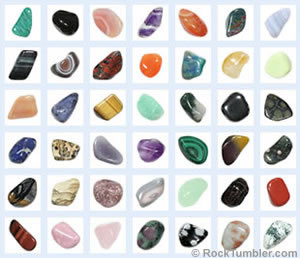How Our Tumbled Stone Mixtures Are Made
(Also, where they come from and what our customers do with them)

What Are Tumbled Stone Mixtures?
The "tumbled stone mixtures" that we sell are a random assortment of polished stones. They are made by tumble-polishing natural gem materials collected from many parts of the world - mostly from Africa, Asia, and North America.
The mixtures are sold in bags that contain stones of a specific size range. Extra large stones are about 1 1/8 to 2 inches in maximum dimension, large stones are about 7/8 to 1 3/8 inches, medium stones are about 5/8 to 1 inch, and small stones are about 1/2 to 3/4 inches. For more information about how the stones are sized, please see our article on Tumbled Stone Sizes and Shapes.
Buying mixtures is the most economical way to purchase tumbled stones - that's because you are buying a bulk bag of stones, and the vendor can make them with the types of stones currently being processed instead of sorting, packaging, inventorying, and selling them by variety. You will receive a large assortment of stones that would have cost much more if you had purchased them in single-variety packages.
What Types of Stones Are in the Mixtures?
You will find many different types of stones in our mixtures; however, the specific varieties that you will receive depends upon when you buy. Why? The types of stones in the mixtures changes each time we receive a shipment of stones. So, if you purchase a bag of stones today and then another a few months from now, you will likely see different types of stones in the mixture.
Normally our mixtures contain at least 12 to 18 of the stone types listed below, plus several types of stones not included in this list. To receive the best variety, we recommend purchasing at least three pounds. A one-pound bag will probably not contain an extensive variety of stones because it contains a small number of stones - especially in the large and extra-large sizes.
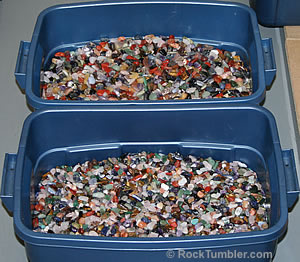
What you see here are some small and medium stones ready to be packaged.
- Rose quartz from Namibia
- Banded amethyst from Namibia
- Yellow quartz from India
- Tiger's-eye from South Africa
- Banded agate from Botswana
- Dalmatian stone from Mexico
- Carnelian agate from Botswana
- Rock crystal from Madagascar
- Green aventurine from Zimbabwe
- Moss agate from India
- Leopard skin from Mexico
- Orange quartz from India
- Picture jasper from Namibia
- Pink aventurine from Canada
- Pink agate from Botswana
- Red jasper from South Africa
- Snowflake obsidian from the United States
- Sodalite from Canada
- White quartz from South Africa
- Yellow jasper from South Africa
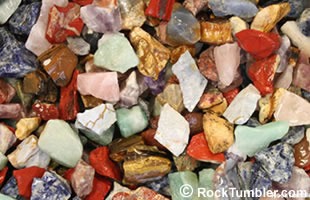
This is some of the rough used to make the polished stones we sell. Get a 20-pound bag to tumble yourself here.
How Are the Tumbled Stones Made?
The tumbled stones that we sell are made from gem materials collected at mines, streams, construction sites, and natural outcroppings. They are usually placed in barrels at the collection site and then shipped by truck or ocean freight to a processing center. There they are broken into tumbling rough, cleaned, and placed into rock tumblers that are large enough to tumble a load of up to 6000 pounds.
They are first tumbled in water and a coarse abrasive grit to wear off rough edges and give the stones a rounded shape. This tumbling action simulates how rocks are tumbled in streams and on beaches to produce the familiar rounded stones that you see in stream channels or on shorelines. The shaping occurs more rapidly in a tumbler than in nature because the abrasive grit is harder and sharper than the sand grains found in nature. The tumbler also runs continuously instead of only during times of high water or storms.
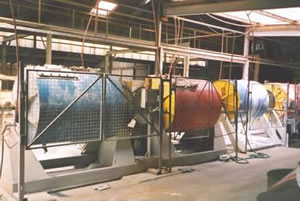
Commercial production of tumbled stones is done in giant 6000-pound capacity rock tumblers. Image courtesy of Craftstones Europe.
It takes a few days to a few weeks to process the rough rocks into finished tumbled stones. The exact amount of time depends upon the hardness and size of the starting materials.

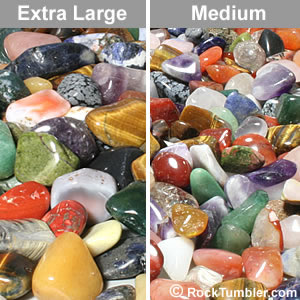
Washing, Sorting, Inspection and Shipment
When the stones are removed from the polishing step of the tumbler, they are washed and sorted into various sizes by sifting them through a stack of screens. The top screen has large openings that allow most stones to fall through, but the extra large stones do not pass. The next screen has slightly smaller openings, catching the large size stones and allowing the smaller stones to pass. Each screen catches one of the size ranges that we offer for sale and allows smaller size stones to fall through.
Sorting the stones to size by screening is much faster, and more economical, than paying people to do that work. However, a disadvantage is that the screening is a little less accurate than human sorting. Long narrow stones can fall through a screen and be found in smaller sizes. Small stones might not find their way through the screens and be included with a larger size. Paying employees to measure and sort the stones accurately by size would significantly increase the cost of the tumbled stones. Most people are glad to receive the screen-sorted stones at a much lower cost.
After screening, the stones are inspected and those with obvious damage or a bad finish are removed. This inspection is only done with the larger size stones because it would be tremendously expensive to do that work with the small and extra small sizes. The stones are then dried and sealed in 800-pound barrels for their journey to the United States by ocean freight. Once in the United States, 800-pound barrels of stones are placed on pallets and delivered by motor freight to our warehouse.
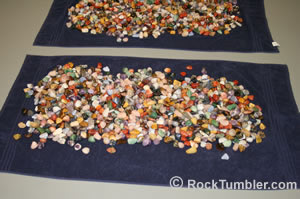
We give the stones a final rinsing to remove any dust or debris from them before packaging.
Another Washing and Packaging
When the stones arrive at our warehouse, we wash them again and allow them to air-dry. They are then handled with scoops, weighed on government-inspected scales, and placed in retail packages. If we see any damaged stones, we remove them before they are packaged. The packaged stones are then stored in our warehouse, awaiting your order.
Filling Special Orders by Color, Size, Shape
Some people ask if we can color-match stones, hand-select flat stones, or pick out stones with specific size requirements. We regret that our small staff is unable to provide these time-consuming services. Selecting stones to meet specific requirements is very costly, and most people would not want to pay the price required. However, the main reason that we do not provide a stone-selection service is that picking out special stones degrades the quality of the mixtures for all other buyers. So, we respectfully decline all requests to hand-select stones.
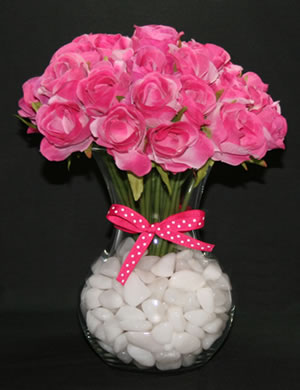
A bouquet of pink roses in a 3.5" x 7" sweetheart vase decorated with a pink ribbon. The gem vase filler is about two pounds of white quartz.
What Happens Next Is Up to You!
Our tumbled stones are purchased by thousands of customers per year. Most of our customers use the stones in craft and decor projects. You can see some samples of how they have been used here.
Perhaps the most popular use is in making jewelry. Many of our customers wire-wrap tumbled stones. Others purchase jewelry findings to make pendants, tie-tacks and keychains from the stones. Some people place tiny tumbled stones into little bottles or lockets and wear them as pendants. There are an unlimited number of ways to use tumbled stones in jewelry.
Plant lovers use tumbled stones as colorful vase filler. Others use them as accents in potted plants, or spread them as a ground cover in planters. A ground cover of stones can prevent evaporation and reflect or absorb heat - depending upon the stones' color.
Teachers use tumbled stones for counting practice. Students can learn the principles of classifying objects with tumbled stones. Some science teachers use tumbled stones in rock identification assignments. We know schools that give students tumbled stones as a reward during a break on standardized test day.
Photographers buy many of our tumbled stones. They use them as colorful accents in photographs. Retailers use a few large tumbled stones or a layer of tiny tumbled stones to add color to display cases.
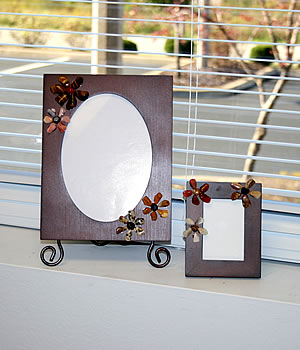
A few tumbled stones glued to a picture frame in the shape of a flower will dress up the frame and give it a three-dimensional character. This is one of the easiest tumbled stone crafts!
We know people who use tumbled stones as "visitation stones" in cemeteries. Others leave a couple beautiful stones on a park bench just to delight the person who finds them. Many people use tumbled stones in meditation or mindfulness practices.
A surprising number of our customers purchase tumbled stones and use them as "healing crystals" or "healing stones". Throughout history and in all parts of the world, people have used beautiful stones as part of their healing, spiritual, and religious practices. We know of no scientific evidence that these practices are effective - other than because of the placebo effect.
We believe that the main benefit of tumbled stones is in their color and beauty and the joy that you experience while being creative with them or using them in your home, office, or yard. There is also a reward of sharing your stones with a friend, family member, or even someone you don't know. It's easy to find others who like shiny colorful stones.
RockTumbler.com Authors
 |
Hobart M. King has decades of rock tumbling experience and writes most of the articles on RockTumbler.com. He has a PhD in geology and is a GIA graduate gemologist. He also writes the articles about rocks, minerals and gems on Geology.com. |



